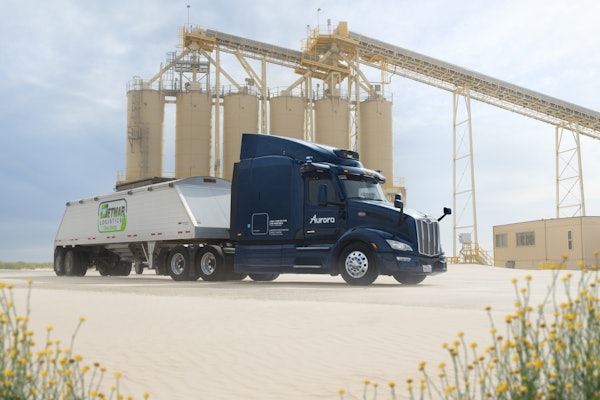Eaton says demand for its automated UltraShift transmissions, such as the LST, is increasing.
Some in the industry may have been surprised by ArvinMeritor’s decision to focus its transmission marketing entirely on the ZFMeritor Freedomline fully automated 12-speed, but the company was certain it was making the right call.
“We were sure that automated transmissions represent the future,” says Charlie Allen, ArvinMeritor’s national service director for commercial vehicle systems. “Driving the truck is more demanding than ever in terms of all the traffic congestion and all the things we ask the driver to do. Asking the driver to be a powertrain manager – not only making shift decisions, but synchronizing the speeds of transmission parts during shifting – is asking a lot. Also, an automated transmission offers an opportunity to offset the loss in fuel economy with 2007 engines.”
The biggest variable in fuel economy is normally the driver, so automated transmissions can compensate by making optimal use of all the ratios. “There is nothing to pay attention to but shifting,” Allen says. “The transmission does not have to look at the guy ahead, and does not even look beyond the front bumper.”
Even drivers who know exactly how to shift get tired of changing gears when crawling along in stop-and-go traffic. “The driver tries to find a compromise gear,” Allen says. Doing so saves them a lot of work, but leaves the engine turning faster than necessary – and wastes fuel as a result.
The Freedomline transmission has sophisticated shift algorithms, the software that decides when to shift and whether or not to skip a gear, and they are being “honed” continuously to optimize performance and fuel economy, Allen says.
Other reasons ArvinMeritor went for the automated design was the change in driver demographics, and the fact that – with engine torques on the increase – clutch pedal effort is increasing. With more women drivers in trucks, you often end up with a 130-pound driver having to depress a clutch pedal that takes a 60- to 70-pound force, Allen says.
“Right now, we are seeing two distinct trends in transmission sales,” says Stephanie Bell, product planning manager for Eaton and Roadranger. “The first is increasing demand for higher torque models, like our 1,650-pound-feet 10-speed manual FRs, and our automated UltraShift transmissions. Meanwhile, the demand for automated products is also growing.”
Torque is on the increase, Bell says, because the industry continues to place a high priority on fuel economy and good driveability. “To best accomplish this, more and more fleets are spec’ing multi-torque engines – and that, in turn, requires a higher torque or multi-torque transmission,” she says.
Also influencing demand for automated products, says Bell, is the industry’s increasing emphasis on ease of operation: Drivers love the two-pedal concept, and that is helping to curb turnover rates for fleets making the move to automation.
“Another important factor that will drive sales up is the reliability benefits that go with automation,” Bell says. Automation protects the driveline from abuse, thus reducing the cost of downtime and repairs.
However, Bell believes safety probably is the main factor driving interest in automation, due to the attention demands on a good driver who is forced to continually shift a constant-mesh gearbox.
Volvo also has jumped into the automated market with three versions of its I-Shift fully automated 12-speed: These include both direct-drive and overdrive units rated at 1,850 lb.-ft. for Volvo’s 11- and 13-liter engines, and a 2,300 lb.-ft. overdrive unit designed for use with the company’s 16-liter engine.
“In the past few years, we have seen a pretty strong push toward automation,” says Mike Kidd, sales and technical training manager at DESC Automotriz/TTC (Transmission Technology Corp.). Given the increased cost of new engines – $6,000 to $8,000 due to 2007 emissions standards – Kidd says it is too early to tell if this trend will continue.
Neither ArvinMeritor nor Eaton see a significant trend toward multi-speeds, though the Freedomline has steps in the range of 26 to 31 percent, a bit narrower than those of the company’s prior bread-and-butter transmission, the 10-speed.
But Kidd says TTC’s sales of multi-speed transmissions continue to increase. In response to this trend, the company recently introduced a double-overdrive 18-speed with an overall ratio of 21.27 and a .70:1 top gear. “The improved performance from the use of multi-speed transmissions, including improved fuel economy, seems to be driving the trend,” Kidd says.
Proper spec’ing is critical with transmissions. Both Allen and Kidd stressed the importance of spec’ing for adequate torque, and that includes the potential for uprating the engine. “Too often, the customer specifies a transmission for the lowest torque rating of the engine, and later the engine is turned up to its maximum torque rating, and the transmission is subject to failure,” Kidd says.
The transmission needs to complement the entire truck, Bell says. “A truck and the driveline need to be viewed as one harmonious system,” she says.
Allen pinned down one of the most important aspects of the process – the need to tell the engine manufacturer the cruise speed you’ll be running, and to get their gearing recommendations to achieve the optimum balance of performance and fuel economy.









